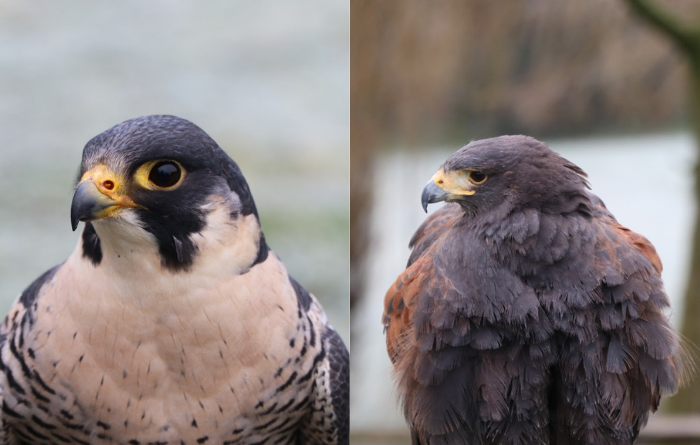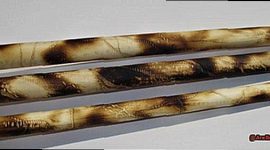
Have you ever looked up at the sky, mesmerized by the graceful flight of a bird of prey?
Maybe you’ve wondered if it’s a hawk or a falcon but had no clue how to tell them apart. Well, don’t worry, fellow nature lovers.
In this blog post, we will uncover the secrets of identifying hawks and falcons so you can confidently recognize these fantastic creatures. We’ll dive into their physical features, flight styles, and hunting techniques to give you all the knowledge you need to effortlessly distinguish a hawk from a falcon.
So, join me on this adventure of bird-watching enlightenment as we unravel the mysteries of these magnificent birds.
How do you tell if a bird is a hawk or a falcon
Contents
- 1 How do you tell if a bird is a hawk or a falcon
- 2 Size: How Big Are Hawks and Falcons?
- 3 Shape and Build: What Makes Hawks and Falcons Different?
- 4 Beak Structure: How Do Hawk and Falcon Beaks Differ?
- 5 Flight Patterns: Observing Hawk and Falcon Flights
- 6 Hunting Techniques: How Do Hawks and Falcons Catch Prey?
- 7 Plumage: Identifying a Hawk or Falcon by its Feathers
- 8 Conclusion
So you’ve spotted a magnificent bird soaring through the sky, but you must check if it’s a hawk or a falcon. Fear not. With a few handy tips and tricks, you can impress your friends with your bird identification skills. Let’s dive into the world of hawks and falcons and learn how to tell them apart.
Size and Appearance:
Hawks are like the bodybuilders of the bird world, with their bulky frames and broad wingspans. They can reach lengths of up to 2 feet or more, making them quite the sight to behold. Conversely, Falcons are like sleek race cars with their slender bodies and long, pointed wings. They’re smaller than hawks, measuring around 1 foot in length.
Flight Patterns:
If birds had their version of the Olympics, hawks would be the synchronized swimmers. They gracefully soar and glide through the air, using thermals to stay aloft. Falcons, on the other hand, are the daredevils of the avian world. They zip through the sky with lightning speed and perform acrobatic maneuvers that will leave you breathless.
Hunting Techniques:
Hawks prefer a more laid-back approach to hunting. They perch on high vantage points and patiently scan the surroundings for potential prey. Once they spot their target, they use their mighty wings to launch themselves into action. Falcons, on the other hand, are like fighter jets in pursuit of their next meal. They hunt while in flight, chasing down their prey with astonishing precision.
Beak Shape:
The beaks of hawks and falcons are like their trusty tools for dining. Hawks have hooked beaks that are sharp and curved downward, perfect for tearing apart small mammals and birds. Conversely, Falcons have notched beaks with a unique “tomial tooth” that helps them deliver swift blows to their prey during high-speed dives.
Plumage and Coloration:
Hawks are the fashionistas of the bird world, sporting a wide variety of plumage patterns and colors. They know how to make an entrance from browns and grays to blacks and whites. Falcons, on the other hand, prefer a more classic look. Their plumage is usually more uniform, sticking to shades of gray or brown.
Size: How Big Are Hawks and Falcons?
Regarding size, hawks and falcons are like the yin and yang of the bird of prey world. While hawks generally tend to be larger, some exceptions keep things interesting.
Hawks: The Mighty Hunters
Hawks are known for their impressive size and powerful presence. Depending on the species, they can range in wingspan from 20 inches to a whopping 56 inches. The Ferruginous Hawk takes the crown as the largest hawk, weighing around 3.5 pounds. That’s some severe bird power right there.
Falcons: The Speed Demons
Falcons, on the other hand, are all about speed and agility. They may not be as big as hawks, but they more than makeup for it with their lightning-fast movements. The Peregrine Falcon, one of the fastest birds in the world, boasts a wingspan of around 40 inches and weighs about 2 pounds. That’s a whole lot of speed packed into a compact package.
But Wait, There’s More.
Remember, size isn’t everything when identifying these magnificent creatures. There are smaller hawk species like the American Kestrel, with its modest wingspan of around 20 inches and weighing only about 3.5 ounces. On the flip side, the Red-tailed Hawk is a larger hawk species that can match the Ferruginous Hawk’s wingspan of up to 56 inches. Size can be a helpful clue, but it’s not the be-all and end-all.
So, watch for the size differences between hawks and falcons next time you’re out birdwatching or just marveling at nature’s wonders. But remember also to consider their behavior, wing shape, and plumage – every detail adds to the story of these magnificent birds.
Shape and Build: What Makes Hawks and Falcons Different?
Regarding birds of prey, hawks and falcons are two captivating species that often capture the imagination of bird enthusiasts. While they belong to the same family, these majestic creatures differ in several aspects of their shape and build. Let’s dive into the distinctions between hawks and falcons, shall we?
Size Matters
The hawks are the heavyweight champions of the raptor world. They boast a larger and more robust body structure than their falcon counterparts. With broader wings and a sturdy frame, hawks effortlessly glide through the sky, showcasing their impressive size. On the other hand, falcons are smaller and more streamlined. Their slender wings allow them to achieve astonishing speeds during flight, making them the speedsters of the avian world.
Wing Shape: Glide or Dive
Hawks’ broad, rounded wings are perfect for sustained gliding flights. These wings provide excellent maneuverability and enable hawks to cover long distances with minimal effort. Falcons, however, sport long, pointed wings that enhance their speed and agility. These aerodynamic wings allow falcons to perform hair-raising aerial maneuvers and dive at exhilarating speeds while hunting.
Beaks: Tear or Taper
The shape of their beaks is another differentiating factor between hawks and falcons. Hawks have a hooked beak that curves downwards, ideally suited for tearing into larger prey such as rodents or small mammals. Falcons, on the other hand, flaunt a notched beak that is sharp and tapered. This specialized beak design helps them deliver precise and powerful bites to break the necks of their prey mid-air.
Hunting Strategies: Sit-and-Wait vs. High-Speed Pursuits
Hawks rely on their exceptional eyesight and employ a sit-and-wait approach to hunting. Perched high on trees or utility poles, they patiently observe their surroundings for any movement indicating potential prey. Once they spot their target, hawks swoop down from above with lightning speed, using their strong paws to snatch their prey.
Falcons, however, are masters of high-speed pursuits. Renowned for their incredible speed and aerial hunting prowess, falcons take breathtaking dives towards their prey. With astonishing precision, they strike their prey mid-air, leaving no room for escape.
Coloration: A Feast for the Eyes
Hawks and falcons exhibit a wide range of plumage variations, making them a feast for the eyes. However, it’s important to note that color patterns alone may not be reliable for distinguishing between the two species. For accurate identification, some hawks and falcons share similar markings, so it’s crucial to consider other physical characteristics like size, wing shape, and beak structure.
Beak Structure: How Do Hawk and Falcon Beaks Differ?
These majestic birds of prey are known for their remarkable hunting skills and impressive aerial abilities. One key feature that sets them apart is their beak structure. In this blog post, we will explore how hawk and falcon beaks differ in shape, size, and function.
Shape:
- Hawks: Hawks have hooked beaks that are sharp and curved at the tip. This shape allows them to tear into their prey effectively, making it easier to dismember and consume.
- Falcons: Falcons, on the other hand, possess notched slender and pointed beaks. The notch or “tooth” near the tip of their beak plays a crucial role in swiftly breaking the neck of their prey during mid-air strikes.
Size:
- Hawks: Hawks generally have larger beaks compared to falcons. This larger size is necessary for capturing and handling larger prey, as hawks tend to target animals such as rabbits or squirrels.
- Falcons: Falcons have slightly smaller, more streamlined beaks. Their smaller size allows them to achieve incredible speeds during flight, making them efficient hunters of birds and smaller mammals.
Function:
- Hawks: The hooked beak structure of hawks is well-suited for securely catching and holding onto prey. Hawks rely on their sharp eyesight to spot prey from a distance, then swoop down for the kill.
- Falcons: Falcons’ notched beaks aid in delivering a precise and lethal strike to their prey while in mid-air. Their streamlined body shape and incredible speed allow them to engage in breathtaking dives, making them expert aerial hunters.
Insights:
Based on my first-hand experiences observing these magnificent creatures, I can attest to the differences in beak structure between hawks and falcons. Hawks’ hooked beaks are visibly curved and formidable, while falcons’ notched beaks have a more pointed appearance. These unique features allow each species to excel in their respective hunting strategies.
In conclusion, understanding the distinctions in beak structure between hawks and falcons can aid bird enthusiasts and researchers in accurately identifying these birds in the wild. Observing their beak shape, size, and function makes it easier to determine whether a bird belongs to the hawk or falcon family. So, the next time you spot a bird of prey, take a closer look at its beak – it could reveal fascinating insights about its hunting prowess.
Flight Patterns: Observing Hawk and Falcon Flights
Differences in Flight Styles
Hawks and falcons may both be birds of prey, but their flight patterns are as different as night and day. Understanding these unique flight styles can help birdwatchers accurately identify these magnificent creatures in the wild.
Soaring Hawks
Hawks are known for their graceful soaring flight. They effortlessly glide through the air, riding thermal currents to gain altitude and cover large distances. Their broad and rounded wings enable efficient gliding and provide stability during their leisurely flights.
Acrobatic Falcons
Falcons, on the other hand, are the daredevils of the bird world. With their agile and acrobatic flight style, they perform impressive aerial maneuvers that leave spectators in awe. Falcons are renowned for their high-speed dives, known as “stoops,” where they plummet toward the ground with astonishing precision. Their pointed wings allow them to change direction quickly and achieve incredible speeds during their hunts.
Key Observations
When it comes to observing hawk and falcon flights, there are a few key observations to keep in mind:
Wingbeats
Hawks maintain a slow and steady rhythm with their wingbeats. They flap their wings once or twice before gliding, creating a rhythmic pattern in the sky. Falcons, on the contrary, have rapid wingbeats. They beat their wings rapidly and continuously, allowing them to maintain speed and agility during flight.
Hunting Behavior
Hawks prefer a more patient hunting approach. They scan the ground from a high perch before swooping to capture their prey. Falcons, on the other hand, are known for their high-speed aerial pursuits. They chase their prey in mid-air, utilizing their incredible speed and maneuverability to catch it.
Size and Plumage
Size plays a role in distinguishing hawks from falcons. Hawks generally have larger bodies and longer wingspans compared to falcons. Additionally, the coloration of their plumage can provide clues about their identity. Hawks often have brown or grayish feathers with mottled patterns, blending into their surroundings. Conversely, Falcons may exhibit more vibrant colors like black, white, or shades of gray.
- Expert Tip: Studying field guides or consulting experienced birdwatchers can provide valuable insights into the specific flight patterns and physical characteristics of different hawk and falcon species. This knowledge will greatly assist in accurately identifying these magnificent birds in the wild.
Hunting Techniques: How Do Hawks and Falcons Catch Prey?
Regarding hunting, hawks and falcons are true masters of the sky. These birds of prey have evolved incredible techniques and adaptations that allow them to catch their game with precision and efficiency. This section will explore how hawks and falcons utilize their vision, speed, agility, talons, and beaks to become formidable hunters.
- Vision: Hawks and falcons possess exceptional eyesight, which is crucial for spotting their prey from high altitudes. Their eyes are specially adapted to detect motion and focus on distant objects. This keen vision allows them to scan vast areas and pinpoint potential targets.
- Speed and Agility: Hawks and falcons employ different hunting styles based on their unique characteristics. Hawks rely on soaring and swooping techniques. They perch high in trees or on elevated structures, using their sharp eyes to search for prey below. Once they spot a target, they dive down with lightning speed, reaching incredible velocities to surprise their prey.
Falcons, on the other hand, are renowned for their exceptional speed and agility. They can reach astonishing speeds during their hunting dives, making them one of the fastest animals on Earth. Falcons use a ” stooping technique,” where they soar high above their prey before descending rapidly to catch it off guard.
- Talons: Both hawks and falcons have sharp nails that they use to grasp and immobilize their prey. These talons are designed to be strong and sharp, allowing them to hold onto their catch securely. Once captured, they use their powerful grip to prevent the prey from escaping.
- Beaks: Hawks and falcons have hooked beaks adept at tearing into flesh. Their beaks are designed to tear apart their catch into manageable pieces for consumption efficiently. Their sharp beaks can quickly dispatch their prey and begin feeding.
- Adaptability: Hawks and falcons are not limited to a single hunting technique. They possess remarkable instincts and can adapt their strategies based on the type of prey they are pursuing. They adjust their flight patterns, speed, and tactics to increase their chances of capturing food successfully.
Comparing Hawks and Falcons:
Here is a table summarizing the main differences between hawks and falcons in terms of their hunting techniques:
| | Hawks | Falcons |
|—————|——————————-|—————————————|
| Hunting Style | Soaring and swooping | Stooping and high-speed dives |
| Speed | Fast, but not as fast as falcons | Exceptionally fast |
| Agility | Agile, but not as agile as falcons | Highly maneuverable |
| Nocturnal Hunting | No | Some falcon species hunt at night |
Plumage: Identifying a Hawk or Falcon by its Feathers
Plumage: Identifying a Hawk or Falcon by its Feathers
Have you ever looked up at the sky and wondered if that bird soaring above you is a hawk or a falcon? Well, wonder no more. By examining these majestic birds’ plumage, or feathers, you can easily distinguish between the two.
Wing Shape and Tail Length
Hawks typically have broader wings and longer tails compared to falcons. This adaptation allows hawks to soar effortlessly while scanning for prey. On the other hand, falcons have more streamlined bodies and longer wings, enabling them to achieve incredible speeds during their high-speed aerial pursuits.
Color and Pattern
A mix of brown, gray, and white feathers often characterizes the plumage of hawks. This combination provides excellent camouflage in their natural habitats. Some hawk species, such as the Red-tailed Hawk, display distinct reddish-brown feathers on their tails, making them easily recognizable.
Falcons, on the other hand, sport dark feathers with lighter undersides. This coloration provides effective aerial camouflage when they are hunting from above. Additionally, falcons often have distinct patterns on their faces or heads. The Peregrine Falcon, for example, has “mustache” markings that are unique to this species.
Wing Pits
One key plumage characteristic distinguishing falcons from hawks is the presence of dark “wing pits” or marks on the underside of their wings. These marks are absent in hawks and serve as a definitive identification feature for falcons.
Hawk Plumage:
- Broad wings and longer tails
- Mix of brown, gray, and white feathers
- Reddish-brown tail feathers (e.g., Red-tailed Hawk)
Falcon Plumage:
- Streamlined bodies and longer wings
- Dark feathers with lighter undersides
- Distinct patterns on the face or head (e.g., “mustache” markings in Peregrine Falcon)
- Dark “wing pits” on the underside of wings
Conclusion
Determining whether a bird is a hawk or a falcon can be challenging. However, with keen observation and knowledge of their distinguishing characteristics, you can become an expert in telling these magnificent creatures apart.
One way to differentiate between hawks and falcons is by examining their size. Hawks tend to be larger, with broad wingspans that allow them to soar effortlessly through the sky. On the other hand, falcons are more compact and streamlined, built for speed as they dive through the air in pursuit of their prey.
Another clue lies in their flight patterns. Hawks often glide gracefully on thermal currents, using their sharp eyesight to scan for potential meals below. Conversely, Falcons display incredible agility and speed as they perform daring aerial acrobatics during hunts.
The shape of their beaks can also offer valuable insight. Hawks possess solid and curved beaks designed for tearing into flesh and devouring their catch. Falcons, however, boast a distinctive notched or “toothed” beak that aids in severing the spinal cords of their prey swiftly and efficiently.
Furthermore, observing their hunting techniques can provide further clues. Hawks are known for their patient perching behavior, patiently waiting for an opportunity to strike from above. Falcons employ a different strategy altogether – they utilize high-speed dives called stoops to surprise and capture their unsuspecting victims.
Lastly, paying attention to their plumage can aid in identification. Hawks often exhibit mottled or streaked feathers that help camouflage them, perched in trees or soaring overhead. Falcons typically showcase sleek feathers with distinct patterns that enable them to blend seamlessly into various environments.
Becoming proficient at distinguishing hawks from falcons takes practice and honed observation skills.


